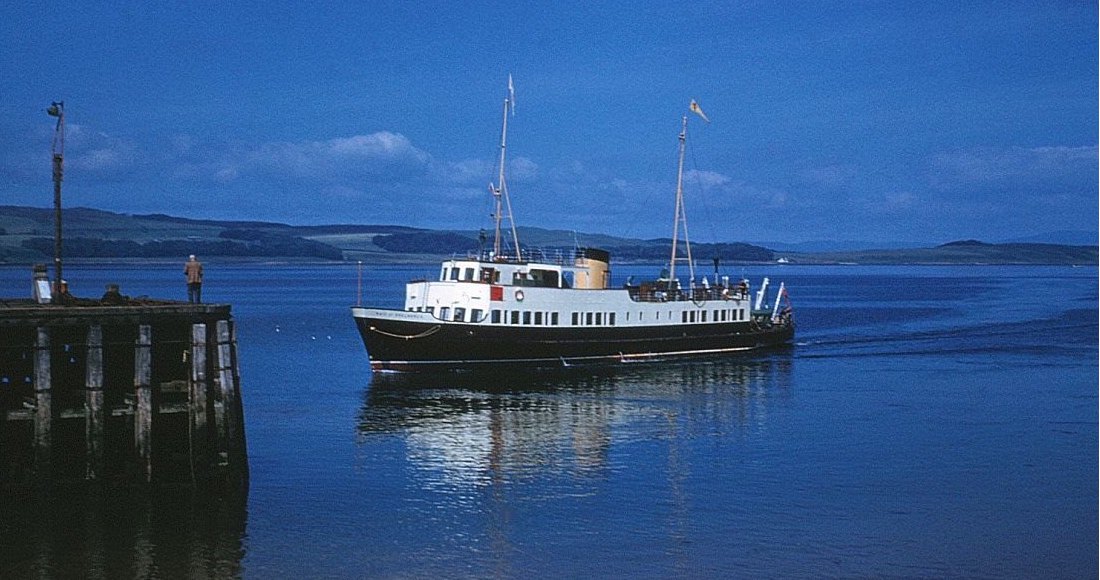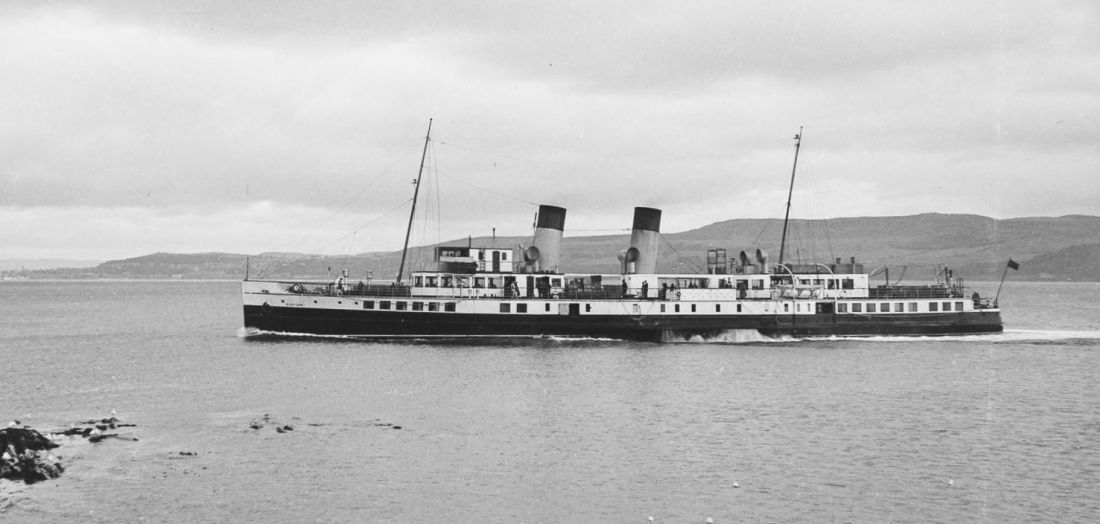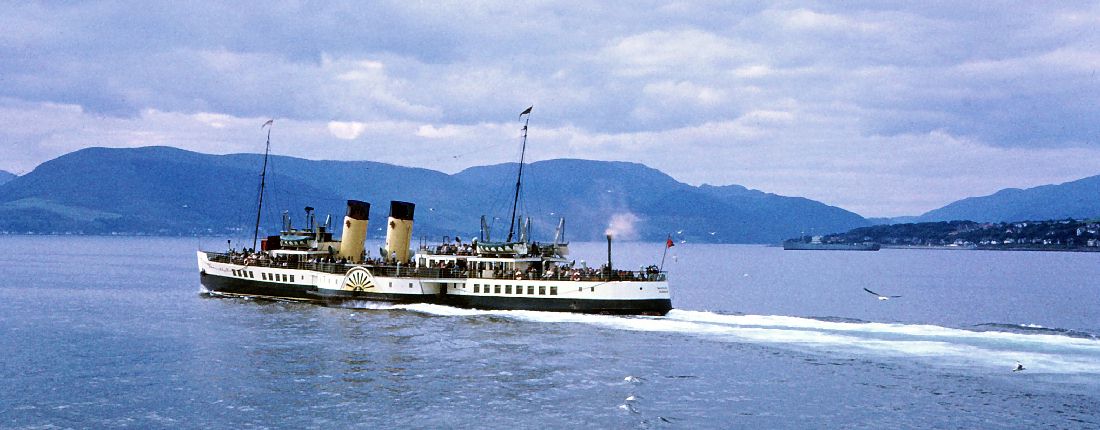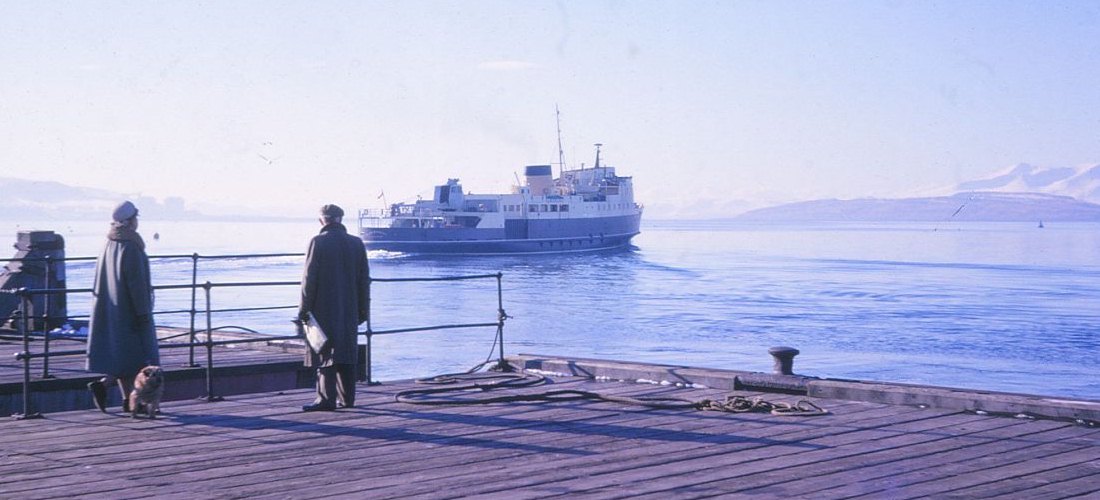
paddlesteamers.info : The Internet's leading database of Paddle Steamers past and present

Jupiter (above) and her sister Juno were launched in 1937 and were the final paddle steamers ordered by the Caledonian Steam Packet Company.
Photo by James Dobie (by kind courtesy of Gordon Provan)
Probably the most recalled anecdote about Clyde Steamers is the
suggestion of Captain James Williamson, son of steamboat owner
Captain Alexander Williamson, that instead of relying on private
owners to provide connections to the new railway services reaching
the coast, the Caledonian should operate its own fleet. The
Caledonian decision led to the introduction of new vessels, matched
by their competitors, the Glasgow & South Western Railway and the
start of a ruinous struggle for supremacy on the Clyde. The last
decade of the 19th century led the great improvements in the quality
of vessels and the provision of fast, frequent, but ultimately
uneconomic, services.
Throughout the 20 th century a constant battle was fought against
rising costs and, after the Second World War, declining demand.
Amalgamation of the Caledonian and G&SWR in 1923 and
nationalisation, incorporating her L&NER competitors from 1948,
allowed the end to the wasteful duplication of services but changing
travel patterns led to the need for a radical reassessment of service
patterns. The era of passenger-only ferries was over by the time that
the CSP passed to STG control on Jan 1st 1969. The withdrawal of
Caledonia (1969), Duchess of Hamilton (1970), Waverley (1973) and
Queen Mary (1977) signalled the rapid end for the traditional Clyde
steamer in favour of highly efficient car ferry links across the
Firth. Happily, Waverley has shown that, suitably marketed, there is
still a role for cruising, albeit against all the expectations of
Caledonian MacBrayne.
For details about turbine steamers (designated TS), please go to the Clyde Turbine Steamers website
Steamers purchased in 1888 from Captains Peter & Alec Campbell
No steamers were built for the Caledonian company after World War II (although they were eventually to assume ownership of the LNER's immediate post-war Waverley). The early 1950s saw the start of a radical programme of dieselisation and a significant re-shaping of the fleet

When the Caledonian Steam Packet Company was formally dissolved and the new merged entity Caledonian-MacBrayne was established in 1972, Waverley was the last operational paddle steamer. She had been built for the London & North Eastern Railway, originally fierce competitors of the Caledonian, and following railway nationalisation was eventually transferred into the Caledonian fleet
MOTOR VESSELS
Passenger Ships
Maid of Argyle
(1953)
Maid of Ashton (1953)
Maid of
Cumbrae (1953)
Maid of Skelmorlie (1953)

In 1953, four sisters appeared as part of a radical
modernisation and cost cutting programme. Replacing much larger
steamers, these motor vessels were not exactly welcomed by the travelling
public, but became familiar on the upper Firth providing railway
connections and short cruises. Named "Maid" this perhaps
accurately reflected their status in comparison with the Kings,
Queens and Duchesses in the fleet
Despite their much lower
costs, they survived no longer than some of the older steamers as
the decline in passenger numbers in the late 1960s and the policy
of moving to virtual exclusivity of car-ferry services, especially
under Caledonian-MacBrayne mangement, sealed their fate (one even
being rebuilt for interim use as a car ferry). They were decent
vessels however and three found new employement in the Mediterranean
and one as a floating restaurant in London
Above: Maid of
Skelmorlie approches Largs pier in the early 1960s. Photo by James
W Jeffrey
Smaller Passenger Motor
Vessels
MV Arran Mail (1936-51) - built to offer extra mail and cargo services to Arran
MV Ashton (1938-65) -
built to offer Clyde river trips to visitors to the Empire Exhibition (Glasgow 1938) then employed to support upper-Firth
connections
MV Leven (1938-65) - as for MV Ashton
MV
Countess of
Bredalbane (1952-71) - Built 1936 for Loch Awe. Transported overland to Loch Fyne in
1952. Versatile, but mainly on the Holy Loch run
MV
Keppel (1967-93) - Built 1961 for the Gravesend-Tilbury
ferry service. Replaced Talisman on the Millport run. Later on "inter-resort cruises" for Cal-Mac
Ashton,
Leven and Keppel still survive (at 2020) away from the Clyde. Countess
of Bredalbane's final duties were as cruise vessel on Loch Lomond
(from 1982, named Countess Fiona) until laid up (1989) and scrapped
(1999). Arran Mail found her way to Gibraltar. She was lost at sea with
all her crew in 1962 having been bought for use at Alderney
